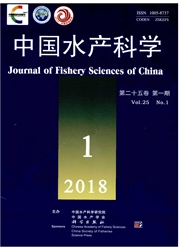

 中文摘要:
中文摘要:
通过增殖放流,增加优质渔业资源、改善种群结构是渔业资源养护的重要手段,而增殖生态容量的研究是科学实施增殖放流的前提。为确定海州湾中国明对虾的生态容纳量,根据2013年连云港海州湾渔业生态修复水域的调查资料,应用Ecopath with Ecosim(EwE)软件中的Ecopath模块,构建了该区域的生态系统能量流动简易模型,计算了放流种类中国明对虾的增殖生态容纳量。结果表明:系统各功能组营养级范围在1~4.42。系统总流量9335.191 t·km^–2·a–1,系统总初级生产力3892.630 t·km^–2·a–1,系统初级生产力与总呼吸量的比值为1.331,连接指数为0.415,杂食指数为0.174,Finn循环指数为11.4%,平均能流路径为2.8系统尚处于由衰竭状态向恢复状态转变,还未恢复到成熟态。中国明对虾不是本海域的关键种,当前中国明对虾的生物量为0.04 t·km^–2·a–1,中国明对虾的生态容纳量为0.846 t·km^–2·a–1。
 英文摘要:
英文摘要:
In order to protect the wild population and genetic resources of Chinese shrimp (Fenneropenaeus chinensis), stock enhancement activities about Chinese shrimp had been carried out since 1980s in Haizhou Bay. Stock enhancement is an important way of fishery resources conservation, which can increase the high quality fishery resources and improve the fish population structure. However, scientific management of stock enhance-ment need to understand the carrying capacity of target species. Based on the data of biological resources obtained from an investigation of Haizhou Bay in 2013, a balanced trophic model of the area was constructed using the Ecopath with Ecosim software package. The effects of uncertainty of input parameters and Ecopath analysis sensi-tivity were explored. Trophic flow and system attributes of the Haizhou Bay ecosystem were analyzed. The eco-logical carrying capacity for Chinese shrimp were also predicted. The model consisted of 16 functional groups, which covered the main trophic flow in the Haizhou Bay ecosystem. The results showed that the pedigree index of the model was 0.588, indicated that the model input parameters were robust and reliable. The input parameters hav-ing the greatest effects on the output parameters were the ecotrophic efficiency (EE). Trophic levels of functional groups varied from 1?4.42. The total system throughput in ecosystem was estimated to be 9335.191 ·km^–2·a–1, sum of all production was 3892.630 ·km^–2·a–1, and sum of all consumption was 3838.019 ·km^–2·a–1, total net system production was 822.042 ·km^–2·a–1. The total energy transfer efficiency was 7.9%, transfer efficiency from primary producers and detritus was 6.6% and 9.4%, respectively. The proportion of the total flow originating from detritus was 40%, and that from primary producers was 60%, indicating that the energy flow was dominated by grazing food chain. The ratio of TPP/TR was 1.331, the connectivity index was 0.415, the omnivory index was 0.174, the Finn cycling inde
 同期刊论文项目
同期刊论文项目
 同项目期刊论文
同项目期刊论文
 期刊信息
期刊信息
